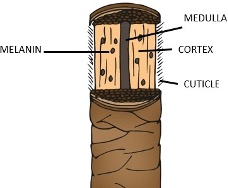Understanding the Hair
Hair is made up of a protein called Keratin which contains the elements oxygen, hydrogen, carbon, sulphur and nitrogen. Keratin is made up of small amino acids which are chemically bounded together by peptide bonds/links which form a long chain’s known as polypeptides chains. The polypeptides contain hundreds of amino acids and may be referred to as “simple proteins”.
Hair is a fibre protein as it contains a large number of cross-bonds or linkages. There are three cross-linkages of the hair:
- Disulphide bonds
- Salt linkages
- Hydrogen bonds
Each hair is composed of three layers, the outer layer, which is the cuticle, followed by the cortex which is the main bulk of the hair, and the centre of the hair is the medulla. Not all hairs have a medulla present – this is dependent on the diameter of the hair shaft.
Hair Texture
The texture of hair is defined by thickness of individual hairs and how the hair feels, generally coming under the headings of coarse, medium or fine. Some people can have coarse hair but a thin density, whereas others may have fine hair but greater density.
The Hair Growth Cycle
The hair growth cycle consists of four phases – growth, regressing, resting, and shedding; which respectively we term ‘anagen’, ‘catagen’ and ‘telogen’ and ‘exogen’. Its discovery was one of the most important breakthroughs in Trichology, but initially presented nearly as many questions as it did answers. From a clinical and experimental perspective, one of the most important aspects is that epilated (plucked) hairs have a different morphological appearance in each of the phases.
There are approximately 80,000 to 150,000 follicles on the human scalp, however, not all are productive at the same time. In anagen, the follicle reaches its maximum size. This is the period of growth and mitotic activity, of a duration anything from two to seven years, with an average about 1,000 days. The Telogen (resting) phase of the hair typically lasts for about 100 days (3 months). The actual duration of the hair cycle is determined by genetics, age, diet, health, etc.
Follicles, which shed their hairs at the end of normal telogen may sometimes fail to re-enter anagen, and a diffuse thinning of the scalp hair then develops slowly and in the absence of any increase in hair shedding.
It is normal to lose between 50-150 hairs per day, when brushing, combing, or shampooing. The number of hairs an individual typically loses can vary greatly from person to person, however, it is the change within an individual that is critical if you are concerned about excessive hair loss. If new hairs are growing at the same rate hair is falling out, there will be no difference in hair density. However, if the hair is shedding at a faster rate that it is being produced, hair loss occurs.


